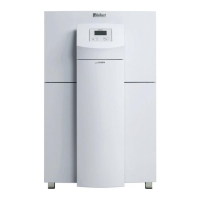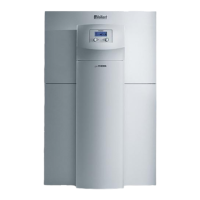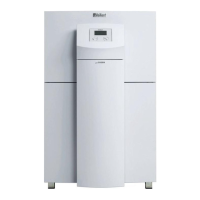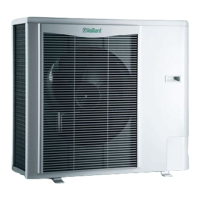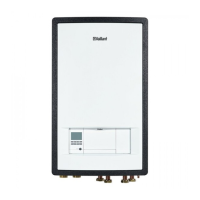Appendix
0020250180_00 geoTHERM Installation and maintenance instructions 37
Code
Meaning Cause
Remedy
F.723
Building circuit: Pressure too low – Pressure drop in the building circuit
due to leakages or air pockets
– Building circuit pressure sensor de-
fective
– Check the building circuit for
leaks
– Top up with water, purge
– Check the quality of the plug
contact on the PCB and on the
cable harness
– Check that the pressure sensor
works correctly
– Replace the pressure sensor
F.726
Compressor protector switch opened – Compressor overheated, e.g. as
a result of operating outside of its
application limits
– Maximum environmental temperature
of 40 °C exceeded for the heat pump
– Compressor blocked due to mechan-
ical defect
– Compressor blocked because the
pressure difference is too high when
switched on (> 3 bar)
– Environmental temperatures fall
below 40 °C
– Check the pressure difference
during the start-up attempt
F.730
Low pressure switch opened – Low-pressure switch input not
bridged (X22-8 to X22-11)
– Replace the cable harness
F.731
High pressure switch opened – Refrigerant pressure too high. The
integrated high-pressure switch
tripped at 41.5 bar (g)
– Insufficient energy output via the
relevant capacitors
– Purging the building circuit
– Insufficient volume flow as a
result of closing individual room
controls in an underfloor heating
system
– Check the existing dirt filter for
penetrability
– Refrigerant flow rate too low
(e.g. electronic expansion valve
defective, filter blocked)
F.732
Compressor outlet temperature too high The compressor outlet temperature is
above 115 °C:
– Application limits exceeded
– EEV does not work or does not open
correctly
– Refrigerant volume too low
– Check the low-pressure sensor,
compressor inlet sensor and
compressor outlet sensor
– Check the EEV (does the EEV
move to the limit stop? Use the
sensor/actuator test)
– Check the refrigerant volume
(700 g)
– Carry out a leak-tightness test
F.733
Evaporation temperature too low – No flow rate in the environment cir-
cuit (heating mode)
– Energy input too low in the environ-
ment circuit (heating mode) or build-
ing circuit (cooling mode)
– Check the flow rate in the envir-
onment circuit
– Check the dimensioning of the
environment circuit (heating
mode)
– If the building circuit contains
thermostatic valves, check that
they are suitable for cooling
mode (cooling mode)
– Check the low-pressure sensor
and compressor inlet sensor
F.734
Condensation temperature too low – Temperature in the building circuit
(heating mode) or environment cir-
cuit (cooling mode) too low for com-
pressor operation
– Refrigerant volume too low
– Check the EEV (does the EEV
move to the limit stop? Use the
sensor/actuator test)
– Check the compressor inlet
sensor, high-pressure sensor
and low-pressure sensor
– Check the refrigerant volume
(700 g)
– Leak-tightness test
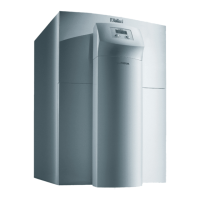
